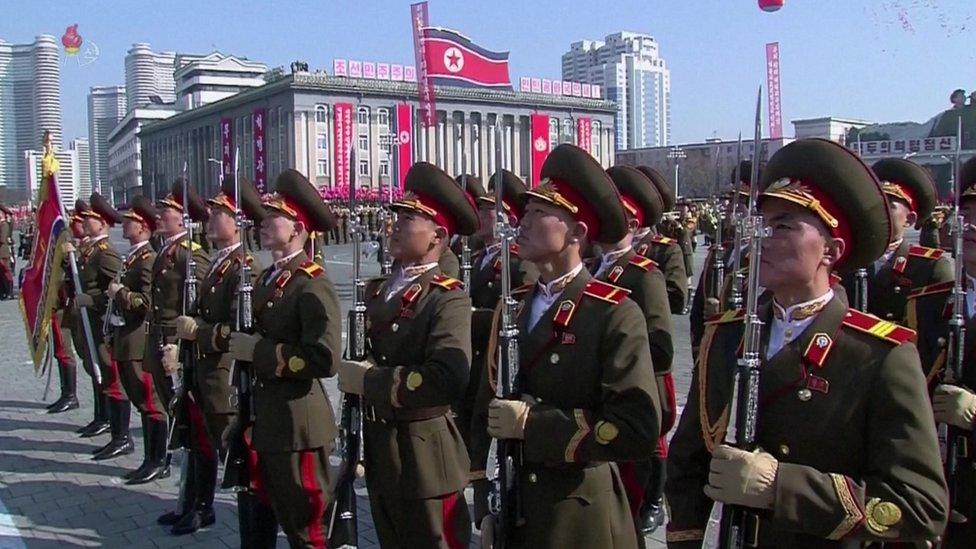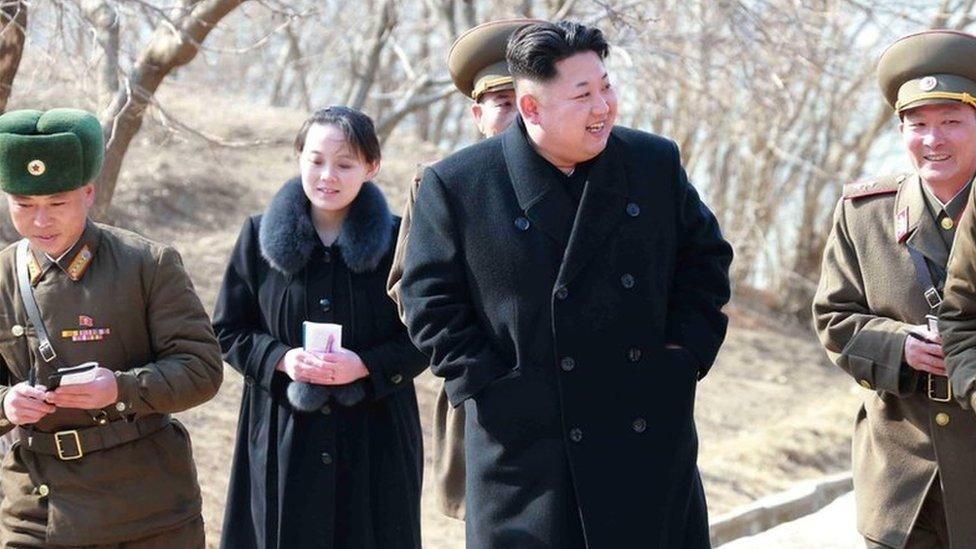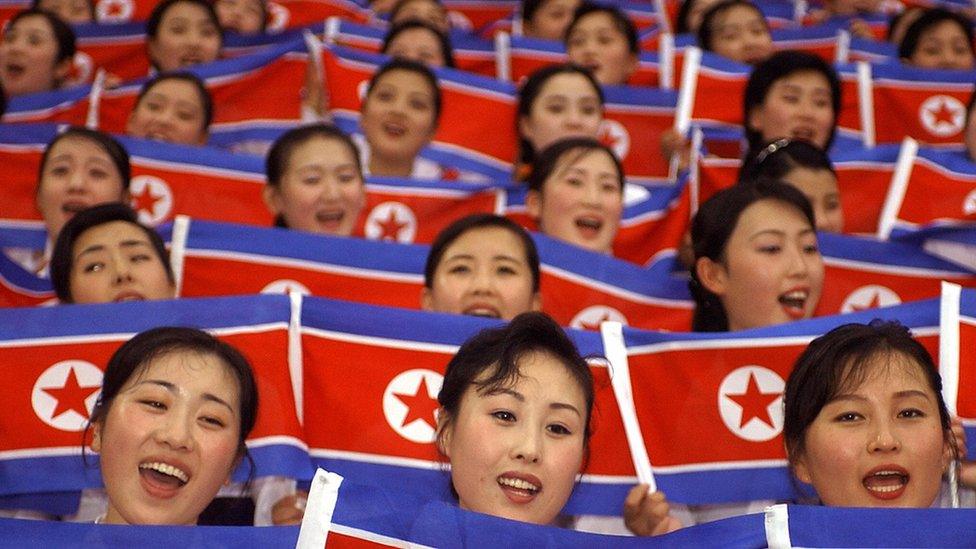North Korea holds military parade ahead of Winter Olympics
- Published
Kim Jong-un and his wife Ri Sol-ju were hailed at the parade
North Korea has held a military parade attended by leader Kim Jong-un, a day before the opening of the Winter Olympics in the South.
The North often boasts of its parades but reports of this surfaced afterwards with TV only airing delayed footage.
This event is usually held in April and moving it had been seen as a setback to the warming of ties over the Olympics.
But the South announced on Thursday its president would meet the North's Olympics delegation on Saturday.
Moon Jae-in will have lunch with the 22-strong team, which will include the North's ceremonial head of state, Kim Yong-nam, and Kim Yo-jong, the influential sister of Kim Jong-un who will become the first member of the ruling dynasty to visit the South. Both were at the parade.
What do we know about the parade?
Early on Thursday state TV began showing patriotic films in what appeared to be a prelude to a live broadcast.
But delayed and unscheduled footage of the event only appeared on TV in the North at 17:00 local time (08:30 GMT).

The parade this year marks the 70th anniversary of the foundation of the Korean People's Army
The parade was reportedly smaller than recent years and the footage showed Kim Jong-un inspecting troops, alongside his wife Ri Sol-ju. There was the traditional goose-steeping and a show of heavy weapons.
Mr Kim said the North had become a "world-class military power".
The annual parade, which this year marks the 70th anniversary of the foundation of the Korean People's Army, is normally held in April and this was the first time in 40 years it had been given a February date.
Such parades are often given a much higher profile. In 2017, North Korea aired a live broadcast of its military parade on state television. Foreign journalists were invited to cover the event.
South Korean government officials said last month that some 13,000 troops and 200 pieces of equipment had been spotted near an airport in Pyongyang in what appeared to be a rehearsal for the parade.

What was on show?
Analysis: Alistair Coleman, BBC Monitoring

While much of the parade was standard fare, it was the event's climax with the appearance of North Korea's missile force that drew the greatest attention.
The stars of the show were four Hwasong-15 ballistic missiles on their nine-axled TEL vehicles (Transport Elevator Launcher).
The Hwasong-15 made its maiden flight in November last year and has a claimed range of more than 13,000km (8,000 miles), which would theoretically put Washington DC in range.
It's the first time that multiple examples of the type have been seen together.
Also on display were several Hwasong-14 missiles (designated KN-20 by the US) on extended truck mounts, as well as Hwasong-12 (KN-17) and Pukguksong-2 (KN-15) intermediate range missiles.
Most notable by their absence were any additional TEL vehicles, possibly meaning the North is still struggling to overcome a shortage.
Some observers also saw possible clones or copies of Russian 9K720 Iskander short-range ballistic missiles.

Why hold the parade now?
The North had insisted on the event, despite criticism from the US and others about its timing - a day before the opening ceremony of the Winter Olympics, which run from 9 to 25 February in the mountain town of Pyeongchang.
It had appeared to be a setback to the rapprochement with the South over the Games, which has generally seen a political charm offensive by the North.
But commentators in the South said avoiding live TV coverage may have been an attempt to keep the parade low key.
The parade is not the only challenge the apparent warming of ties has faced.
There has been criticism in the South about a joint women's ice hockey team, and the North cancelled a pre-Olympics cultural event, citing media bias in the South.
How the attendance of the North's delegation fits in with international sanctions and blacklists has also been a problem.
South Korea has had to ask the UN for an exemption to allow Choe Hwi, a UN sanctioned North Korean official, to attend.
How is the political detente going?
The Games will see both Koreas march under one flag at Friday's opening ceremony.
The South said President Moon would meet the North's team on Saturday, although no location was given.

Kim Yo-jong is seen in a 2015 picture with her brother, touring a military unit
The top officials from the North will arrive by plane on Friday.
Most of its 280-strong delegation, including 229 cheerleaders, four officials from the National Olympic Committee, 26 taekwondo demonstrators and 21 journalists. arrived via a border crossing on Wednesday.
On Thursday, North Korea said it had no intention of meeting US officials during the event.
Who is representing the US at the Games?
Vice-President Mike Pence arrived in South Korea on Thursday and met President Moon later in the day.
Mr Moon said the "most important thing is close co-operation between South Korea and the United States" and that the US's "firm stance" had created the opportunity for North-South dialogue.
The US has been sceptical of the North's actions. Mr Pence said earlier he wanted to "make sure North Korea doesn't use the powerful symbolism in the backdrop of the [Games] to paper over the truth about their regime".
Japanese foreign minister Taro Kono: "N Korea charm offensive shows sanctions work"
He also said the US would soon unveil "the toughest and most aggressive round of economic sanctions on North Korea ever".
Although he did not close the door to talks, saying there was the "possibility for any kind of an encounter", he said he would tell the North it would need to "once and for all abandon its nuclear and ballistic missile ambition".
It has now been confirmed Kim Jong-un's sister will attend Friday's opening ceremony.
The BBC's Laura Bicker in Seoul says this could provide a diplomatic headache, as Mr Pence will be there with the father of Otto Warmbier, who died after being imprisoned in North Korea.
Some of the sport is already under way, ahead of the opening ceremony, including in curling, ski jumping and figure skating.
- Published8 February 2018

- Published9 January 2018

- Published29 November 2017

- Published5 September 2023

- Published15 April 2017
